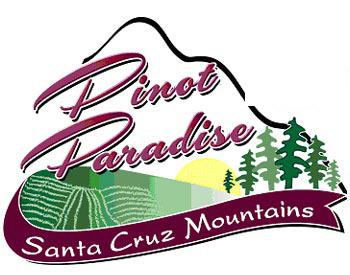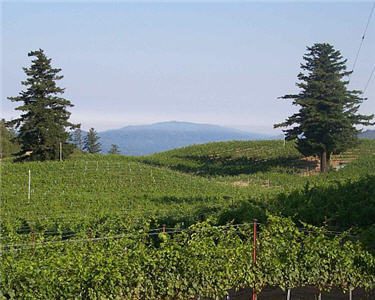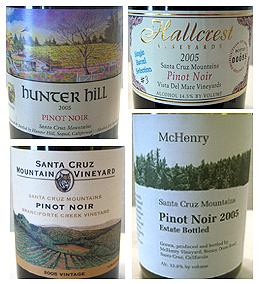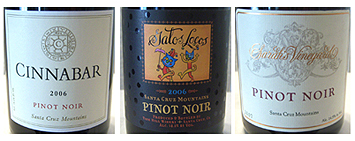

Welcome to Pinot Paradise: That’s what the folks in the Santa Cruz Mountains appellation like to call their neck of the woods. Once you taste their Pinots you’ll see what they mean.
The Renaissance Grape:
Pinot Noir Raises the Stature of the Santa Cruz Mountains
"The best people, like the best wines, come from the hills." ~ Edward Abbey
by
Laura Ness
November 20, 2008
 inemaking in the Santa Cruz Mountains has always included Chardonnay, Cabernet and Pinot Noir. Much has been written about Ridge Vineyards and Cabernet, but it is truly Pinot Noir that has captured the hearts and imaginations of all who toil in the steep, gnarly vineyards set among wild, redwood-covered mountains that make an uneasy peace with the sea below. Like a vaguely glimpsed muse of inspiration, Pinot Noir has rendered otherwise sane individuals completely mad with the obsession of her. It is the stuff of legend here in these majestic, mostly untamed hills, where redwood and poison oak rule.
inemaking in the Santa Cruz Mountains has always included Chardonnay, Cabernet and Pinot Noir. Much has been written about Ridge Vineyards and Cabernet, but it is truly Pinot Noir that has captured the hearts and imaginations of all who toil in the steep, gnarly vineyards set among wild, redwood-covered mountains that make an uneasy peace with the sea below. Like a vaguely glimpsed muse of inspiration, Pinot Noir has rendered otherwise sane individuals completely mad with the obsession of her. It is the stuff of legend here in these majestic, mostly untamed hills, where redwood and poison oak rule.
Pinot obsession here began with the famous cuttings from Burgundy that made their way into Paul Masson’s Saratoga vineyards, which were later taken over by the famous

Pinot Noir in the Santa Cruz Mountains appellation has captured the hearts and imaginations of all who toil in the steep, gnarly vineyards set among wild, redwood-covered mountains that make an uneasy peace with the sea below.
Any wine lover who has lived here for more than 20 years and hasn’t partaken of the old world style, age-worthy Pinots that come from Ken Burnap and Jeff Emery in the heart of the Vine Hill district should be shot. Or they should go visit Jeff at his new tasting room in Santa Cruz and find out what they’ve been missing. Other long-term Pinot-making legends include John Schumacher of Hallcrest Vineyards, who has some of the finest single vineyard examples in the appellation. He’s one of those truly purple Pinot people that are as passionate about Pinot as some are about politics, and he’s pretty passionate about that also.
Tony Craig, perhaps the best known Pinot maker here, learned his craft at David Bruce Winery, and then went on to revive Savannah-Chanelle, where he makes Pinot from many regions. He also crafts Pinot for Silver Mountain, Muns Vineyard and his own label, Sonnet Wine Cellars. He’s the master of extraction and color retention, and was one of the first to make a major switch to Hungarian oak.

Pictured here and below are the wines which advanced to Best-of-Appellation™ and are among entries from the winemakers quoted in this feature.
Relative youngster Ryan Beauregard of Beauregard Vineyards has been making Pinot here for 9 years. He’s fortunate that his lineage is farming, and he had a full pantry of vineyards to choose from, both his own and others that his family was farming. His first vintage was 1999, during the peak of the dot.com bubble when people started planting vineyards like mad and spending upwards of $100 per bottle. He says he started making Pinot “because it grows here!” He credits Mitridat Faravashi from David Bruce Winery with imparting some Pinot wisdom. Ryan’s intent in making Pinot is “Not to make it too aggressive.” He tends to focus on minerality and acidity, and believes that what is common across the range of SCM Pinots is minerality and depth, and of course, he believes the Pinot fruit from his own Bald Mountain, in the Ben Lomond AVA, is the best.
Cinnabar’s alchemist winemaker George Troqauto is a genius and can make something drinkable out of just about anything. With Pinot, his style is ultra-bright fruit,

“My goal with Pinot is to have good color, delicate aromas, sensual mouth feel and good structure. The mountain Vineyards have more structure and minerals, the valley vineyards seem to be richer but not as complex. SCM Pinot has more earth and spice when compared to other appellations, which seem to have more up front fruit. SCM Pinot just seems to have a lot going on, more layer and depth, with less of the uni-dimensional fruit component.” George counts winemakers at Chalone, Testarossa, and David Bruce among those he has turned to for advice.
When he began making Pinot at Mount Eden in 1981, Jeffrey Patterson was introduced to the Pinot protocol established by Martin Ray decades earlier. The vines were planted on 10x10 spacing with no trellising. The gnarled trunks were tied to redwood stakes, as were the basket canes that Ray preferred over the head-pruned method with spurs, which was classic California in the 1940s. Basket canes held fruit at every level, from near the ground to chest high, making for very tricky field sampling. They were going for full ripeness, but this varied tremendously.
Jeffrey recalls that wine consultant Dick Graff thought that 20 to 25 percent dimpling (aka raisining) was acceptable. He also insisted on crushing the fruit, stems and all, into the fermenting bins. “The destemmer attachment was removed and the grapes went right through the rubber rollers,” recalls Patterson. “Dick felt this provided longevity and complexity to the wine. Frankly, I thought they were too stemmy and went away from that practice. Lately, though, I have come back to whole cluster fermentation.”
Back then, they used lots of new French oak, racked once per quarter with a pump










 READER FEEDBACK: To post your comments on this story,
READER FEEDBACK: To post your comments on this story,




